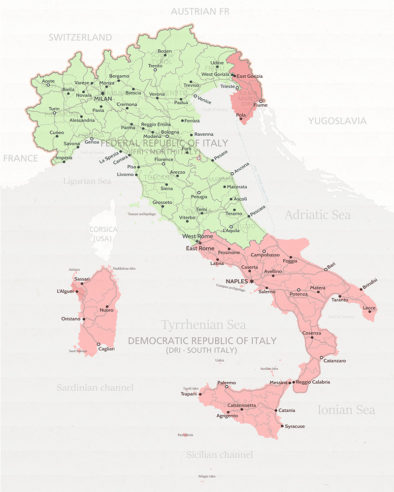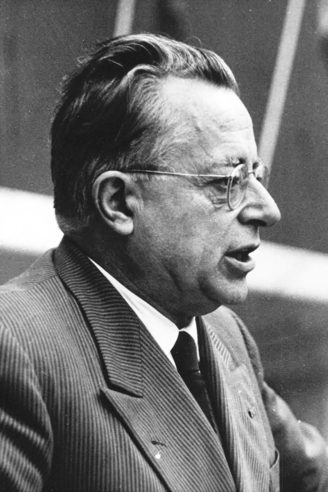
The artist known as “Dom-Bul” imagines what if, instead of Germany, Italy had been divided between East and West during the Cold War.
There are two possible points of divergence:
- The Soviets, rather than the Western Allies, invade southern Italy during World War II. American and British forces land in the south of France (see How to Change World War II) and invade Italy from the north. They meet in the middle of the peninsula, much like Western troops and the Red Army met in the middle of Germany in 1945.
- Civil war breaks out in Italy, not Greece, in 1947. It is the first proxy battle of the Cold War. The Soviet-backed Italian Communist Party, the largest of its kind in Western Europe with more than two million members, prevails in the south. The pro-Western Christian Democrats defend the north. The country is divided much like Korea was in 1953.
A Democratic Republic of Italy is set up in the south and joins the Warsaw Pact. A Federal Republic in the north joins NATO and the European Coal and Steel Community. Rome is divided along the River Tiber with a checkpoint on Garibaldi Bridge.
Ruggero Grieco, in the real world the propaganda chief of the Italian Communist Party, becomes the republic’s first leader and asks Stalin for the return of the Julian March from Yugoslavia. Stalin accepts but Tito resists. The Yugoslav leader only acquiesces when Stalin agrees to incorporate Bulgaria into the Socialist Federal Republic of Yugoslavia, bringing Tito’s dream of a Balkan Federation one step closer. (Bulgarian communist leader Georgi Dimitrov really did agree to merge his country with Yugoslavia but was stopped by Stalin. See Countries That Almost Existed.) Gorizia, on the border with what is now Slovenia, is split in two, like Rome.



Grieco dies of a heart attack in 1955 and is succeeded by Palmiro Togliatti, in the real world the general secretary of the Italian Communist Party from 1934 to 1938, deputy prime minister in Italy’s first postwar democratic government and an admirer of Stalin. His government takes a hard line against organized crime, which in the poor rural communities of southern Italy, especially Sicily, is often the only source of employment for young men. Many leave the Democratic Republic (there is no equivalent to the Berlin Wall to prevent them), settling either in the north, where the economy is booming in the 1960s, or America.
Togliatti dies on holiday in the Crimea in 1964 and is succeeded by Enrico Berlinguer, who in the real world led the Italian Communist Party from 1972 to 1984 and distanced it from Moscow to chart a “third way” between capitalism and the Soviet version of socialism. In this timeline, he is the Italian Khrushchev — except, unlike Khrushchev, he is not deposed. Berlinguer stays in power until his death in 1984 and relaxes both the regime in the south and relations with the West, paving the way for reunification under his successor, Alessandro Natta.



In the real world, Natta led the Italian Communist Party from 1984 to 1988. Here he is leader of the Democratic Republic when the Soviet Union implodes in 1991. The other communist states of Europe are not far behind. Border controls in Rome and Gorizia are lifted. The 1992 Treaty of Rome reunites Italy under northern leadership. The whole country becomes a federal republic. Natta becomes a senator-for-life.






1 Comment
Add YoursPlausibly, it would have to be the Soviets entering the north via Yugoslavia and establishing a state from there.
-They don’t have the amphibious capability to attack from the south and never did even at the height of their Cold War power. They did have, especially in WWII, a much greater ability to attack from the north on land.
-The Italian communists (among the most successful electorally of any western country) never did that well in the south. Their electoral strength was concentrated in Central Italy, the least militarily sustainable location (not near any border).